Wound suturing is one method of wound treatment that many people are familiar with, as in daily life there may be accidents that cause injuries — ranging from small wounds to large ones that require medical treatment, namely suturing. Let’s explore some important facts about wound suturing.
Useful knowledge about wound suturing that you should know:
- What is wound suturing?
- What types of wounds can be sutured?

- What types of wounds should not be sutured?
- Pre-suturing evaluation
- Materials used for suturing
- Instruments used in suturing
- Principles of wound suturing
- Possible complications from suturing
- Advantages of surgical sutures
- Post-suturing care for faster wound healing
- Cost of wound suturing

What is wound suturing?
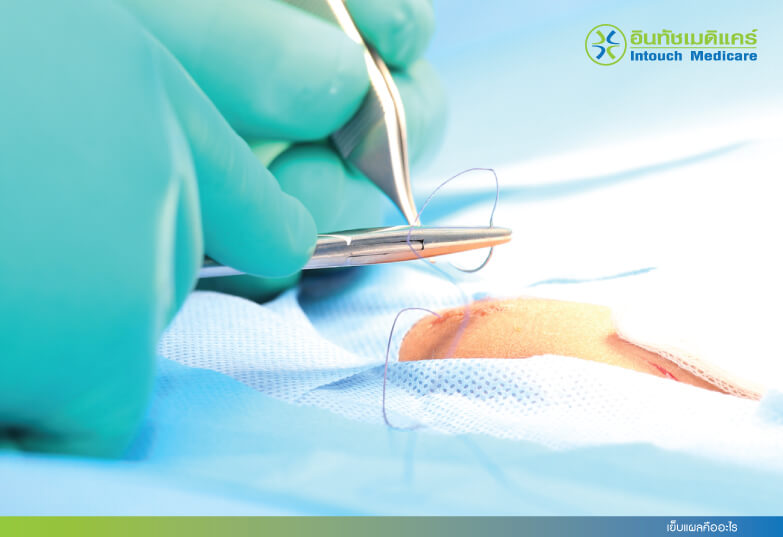
Wound suturing is a clinical procedure within the scope of practice that can be performed by professional nurses and midwives. Before performing any procedure, a proper assessment should be made — especially when encountering patients with wounds — in order to determine whether suturing is necessary or not.
What types of wounds can be sutured?
If the wound edges are widely separated and cannot close on their own, or if the wound is longer than one inch, it should be treated by suturing. Ideally, suturing should be performed within 1-2 hours. ![]() The following types of wounds generally require suturing:
The following types of wounds generally require suturing:
- Wounds with heavy bleeding that cannot be stopped
- Deep wounds exposing muscle or bone
- Wounds with gaping edges
- Wounds involving joints, especially fingers or toes
- Deep puncture wounds from sharp objects
- Wounds caused by foreign objects embedded under the skin
- Bite wounds from humans or animals
- Wounds in areas where scarring should be minimized, such as the face
What Types of Wounds Should Not Be Sutured?

In cases where wounds are caused by dog bites, infected lacerations from sharp objects, contaminated or torn wounds containing foreign bodies or necrotic tissue, or wounds exposed to amniotic fluid or dirty environments, medical practitioners may opt not to perform suturing.
This is because such wounds are classified as contaminated wounds, with a significantly high risk of infection. Immediate closure of an infected wound may delay healing or lead to serious complications, which in some cases could be fatal.

Pre-Suturing Evaluation
- Assessment of blood loss — Determine whether there is visible external bleeding or internal bleeding, which requires further evaluation through vital signs and other clinical indicators.
- Examination of wound size and characteristics
Observe for bruising, hematoma, abrasion, or laceration. Evaluate the condition of tissues within the wound. - Inspection of surrounding skin, foreign bodies, and exudates — Consider administering local anesthesia during evaluation to minimize the patient’s discomfort during examination.
- Assessment of wound dimensions — Evaluate width, length, depth, and whether the wound involves tendon damage or deeper structures.
Suture Material

1. Absorbable Sutures
Also referred to as dissolvable sutures, these are materials that can be broken down and absorbed by the body, eliminating the need for suture removal. Absorbable sutures include both natural and synthetic options. Made from animal intestines (e.g., sheep or bovine), commonly known as catgut:
- Plain catgut: begins to dissolve within 4–10 days
- Chromic catgut: begins to dissolve within 10–20 days
Synthetic absorbable sutures -These are more commonly used in modern — practice due to their smoother texture, greater tensile strength, and reduced risk of inflammation or infection. Examples include:
- Monocryl (Poliglecaprone 25) – retains strength for approximately 21 days
- Vicryl (Polyglactin 910) – retains strength for 3–4 weeks
- PDS (Polydioxanone) – retains strength for 5–6 weeks

2. Non-Absorbable Sutures
These sutures are not degradable by the body and are often used for large or severely damaged wounds requiring prolonged tension. Once wound healing is sufficient, the sutures must be removed by a healthcare professional.
Common non-absorbable suture materials include:
- Silk – economical, easy to knot, stable; can remain for up to 1 year
- Nylon – higher tensile strength than silk, but more difficult to secure
- Cotton
- Polyester
- Polypropylene
In addition to conventional sutures, medical professionals may also utilize preformed wound closure devices such as surgical staples and sterile wound closure tapes, which provide a faster and often more efficient means of wound approximation.
What Instruments Are Used for Wound Suturing?
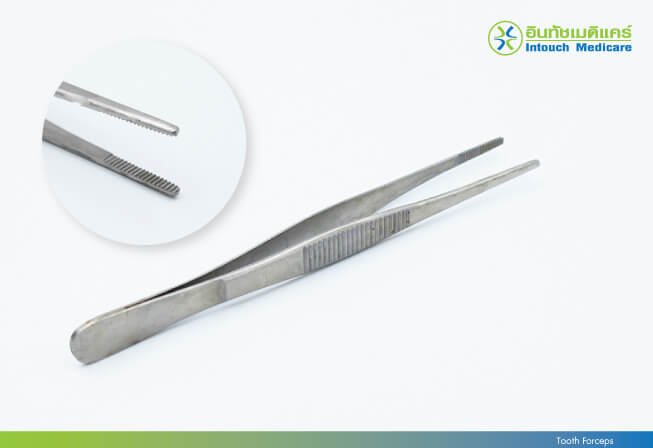
1. Tooth Forceps – Used for grasping external tissues such as the skin. May also be used to handle internal fibrous tissues or fascia if necessary.
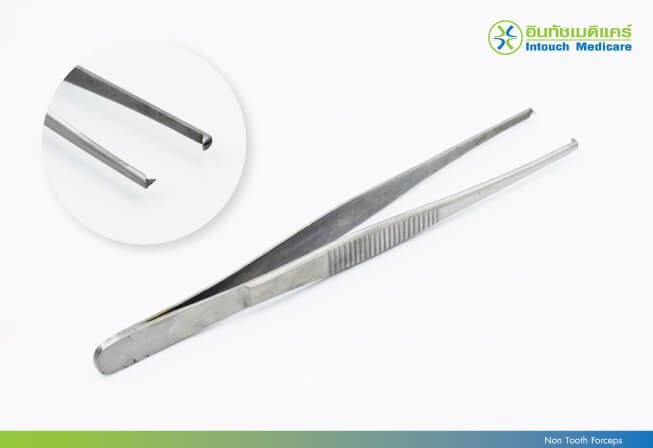
2. Tooth Forceps – Used for grasping external tissues such as the skin. May also be used to handle internal fibrous tissues or fascia if necessary.

3. Needle Holder – Used to securely hold the suture needle, allowing control over the depth and direction of needle insertion during suturing.

4. Suture Scissors – Characteristically designed with one blunt tip and one sharp tip; used specifically for cutting suture threads.
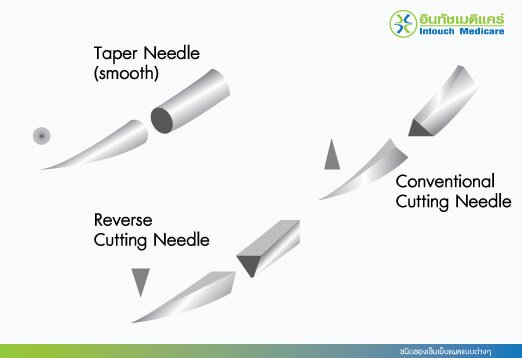
5. Surgical Needles – Available in two primary types: cutting needles and round (tapered) needles, selected based on tissue type and wound characteristics.
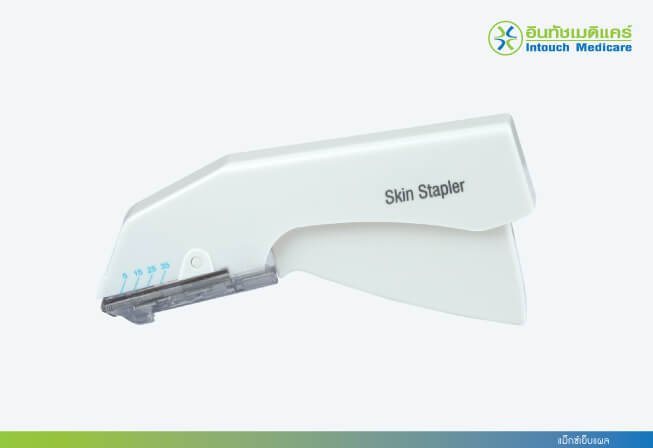
6. Wound Staples – Used based on the physician’s discretion and clinical appropriateness.
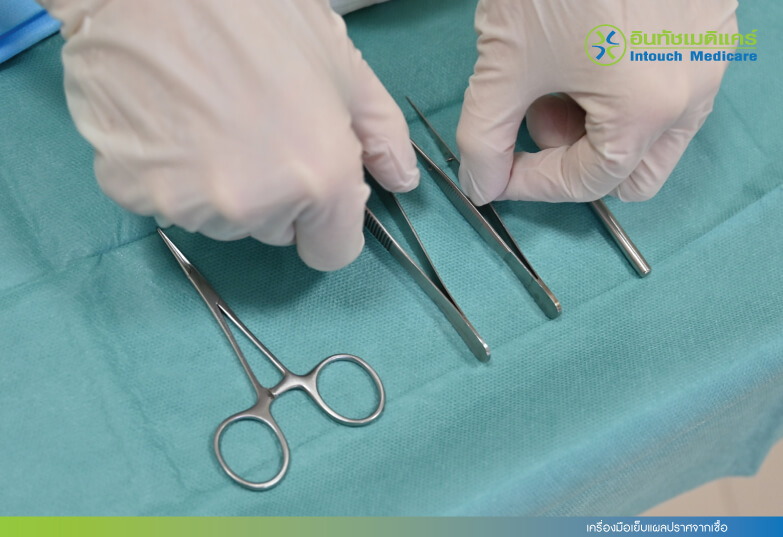
Principles of Wound Suturing
1. Sterile Technique Strict sterile technique must be adhered to, especially wearing sterile gloves before any procedures such as blood collection, wound dressing, or suturing. All sterile instruments and areas must remain uncontaminated by microorganisms or spores to prevent infection.

2. Selection of Appropriate Needle Type
The choice of needle should match the surgeon’s preference and suit the tissue being sutured:
- Cutting Needle: Has a sharp edge, used for tough tissues such as fascia, skin, and tendons.
- Tapered or Round Needle: Used for soft tissues requiring minimal trauma, such as intestines, muscles, glands, blood vessels, or neural sheaths.
- Curved Needles (Tightly Curved): For suturing in narrow or confined spaces.
- Curved Needles (Slightly Curved): For suturing broader wound areas.
- Needle Size: Chosen based on the required depth and amount of tissue to be engaged during stitching.
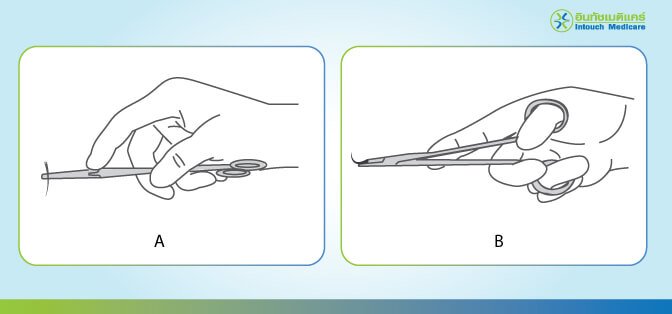
Needle holder grip for suturing: (A) Long needle holder (B) Short needle holder
3. Needle Holder Handling Technique – The needle holder should be gripped firmly in the palm, with the index finger placed near the joint for better stability and precision. For short-type needle holders, a different grip may be required.

Proper needle insertion for suturing:
4. Needle Insertion Angle – Insert the needle perpendicularly (see Image C) to the skin or tissue surface to ensure easier passage. Avoid inserting the needle obliquely (see Image D), as it increases the effective distance and difficulty. The entry point should be adequately spaced from the wound edge.
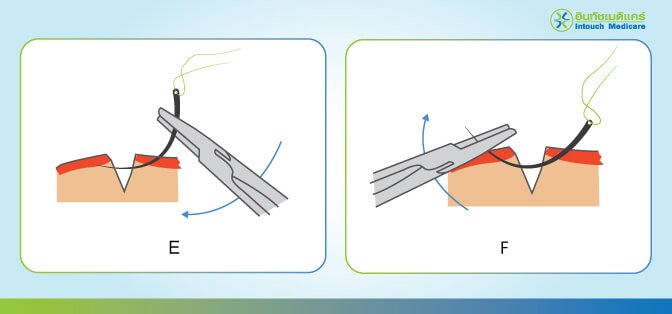
5. Rotating the Needle Through Tissue – Use wrist motion to rotate the needle upwards (see Images E and F), following the curvature of the needle. Avoid applying straight force to prevent breaking the needle. Release the needle holder from the base of the needle and re-grip the emerging tip on the opposite side. Avoid gripping the sharp tip directly to prevent blunting or deformation. Continue rotating until the base exits the skin.
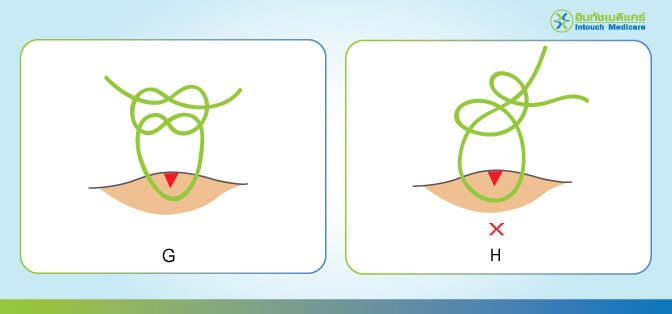
6. Securing the Knot – Use the left hand to hold the proximal end of the suture thread, and the right hand to pull the needle through using the needle holder. Once the thread is through, place the holder down and use both hands to equalize the thread length. Approximate the wound edges and tie a secure knot (see Image G).
7.Cutting the Thread – Use suture scissors to trim the thread, leaving approximately 0.5 cm of the tail. The number of sutures depends on the wound’s length. Typically, each stitch is spaced about 1 cm apart. If gaps are too wide, additional sutures may be inserted between existing ones. For large wounds, reinforcement stitches in the center or double passes of the needle may be required.
What Are the Possible Complications of Wound Suturing?
After suturing, some minor complications may occur, such as fever, excessive pain at the wound site, localized redness, swelling, or burning sensations. Frequent movement of the sutured area may also cause minor bleeding. If any symptoms appear more severe than the above, prompt medical attention is necessary to prevent further complications. Delayed treatment may lead to infection or other serious outcomes.
What Are the Advantages of Using Wound Staples?

In cases where sutures are not utilized, the physician may consider using surgical staples instead, depending on the wound characteristics and the specific properties of staples. The advantages include:
1. Surgical staples can be used for both internal surgical wounds and skin closure, most commonly in cesarean section incisions.
2. The use of staples can reduce wound closure time compared to traditional suturing with thread.
3. Staples help minimize pain at the wound site, reduce the risk of wound infection, and improve the cosmetic outcome of the scar.
4. Skin staples are durable and adhere securely to the patient’s skin.
5. Each staple is supplied in a package with a lightweight, ergonomically designed handle, allowing for clear visualization of the wound and ease of use.
6. The sharp tips of staples reduce tissue trauma during wound closure.
Post-Suture Wound Care for Faster Healing
After a doctor or nurse has sutured a wound, the patient should take proper care of it and strictly follow medical advice. This will help the wound heal properly, reduce the risk of infection, and prevent other possible complications.
1. Avoid getting the wound wet during the first 24 hours after suturing to allow the tissue to start healing and to prevent infection. After 24 hours, you may clean the wound with clean water or saline solution, but always dry it thoroughly.
2. Keep the wound dry until it has fully healed. Avoid bathing or pouring water directly onto the wound. Refrain from activities that may cause moisture, such as swimming, diving, or heavy exercise that produces excessive sweating, including prolonged outdoor exposure.
3. Maintain wound cleanliness by cleaning it regularly as advised by your doctor. Avoid activities that may contaminate the wound and cause infection, such as playing sports, doing housework that involves sweeping or mopping, or playing in dirt or mud—especially in children with sutured wounds.
4. If the wound is on the foot, leg, arm, or hand, try to elevate it above heart level, especially while resting, to reduce swelling that could cause the stitches to pull apart.
5. Avoid strenuous activities until the wound has improved, such as intense exercise or sports with high impact or collision risk (e.g., basketball, volleyball), which could reopen the wound and delay healing.
6. If using a waterproof dressing, keep it clean and dry—especially when bathing. Avoid pouring water directly over it or scrubbing the area to prevent the dressing from coming off.
7. Do not pick, scratch, or rub the stitches to prevent wound reopening and reduce the risk of infection from bacteria on your hands or nails.
8. Take all prescribed medications, especially antibiotics, until finished. If pain occurs, paracetamol or ibuprofen can be taken as directed. Always attend follow-up appointments with your doctor.
9. Watch for signs of infection and seek medical attention immediately if you notice:
- Increasing pain at the wound site with fever, even after taking prescribed medicine.
- Redness, swelling, or warmth around the wound.
- Discharge, pus, bleeding, or foul odor from the wound.
10. Avoid certain foods that may trigger infection or slow healing, such as pickled/fermented foods, alcoholic beverages, spicy food, undercooked food, and foods that may cause allergic reactions (e.g., seafood, fresh milk, nuts).
11. Eat nutrient-rich foods that promote wound healing, such as:
- Protein from meats like fish, pork, and chicken.
- Vegetables and fruits rich in vitamins and minerals (Vitamin C, iron, zinc) such as citrus fruits, leafy greens, and nuts.
- Complex carbohydrates (brown rice, whole grains, sweet potatoes) and healthy fats (olive oil, rice bran oil, avocado) to provide energy and prevent muscle protein loss during recovery.
12. Avoid smoking until the wound has healed, as cigarette smoke contains over 4,000 toxic substances that interfere with wound repair, damage tissue, slow healing, and increase infection risk.

Cost of Wound Suturing
Intouch Medicare Clinic offers wound suturing services.
Starting price: 1,900 THB
Note: This price does not include medication costs. The suturing procedure will depend on the physician’s diagnosis.
References
- Kasian Pangkanon. Minor Surgery Manual, 17th edition. Bangkok: Mor Chao Ban Publishing, 2010.
For more info and make appointment

Onuma Peanphon ,M.D.
General Practitioner
![]() Latest edit : 08/09/2025
Latest edit : 08/09/2025
![]() Images may be used without prior permission exclusively for educational or informational purposes, as long as proper credit is given to intouchmedicare.com
Images may be used without prior permission exclusively for educational or informational purposes, as long as proper credit is given to intouchmedicare.com


 MM
MM